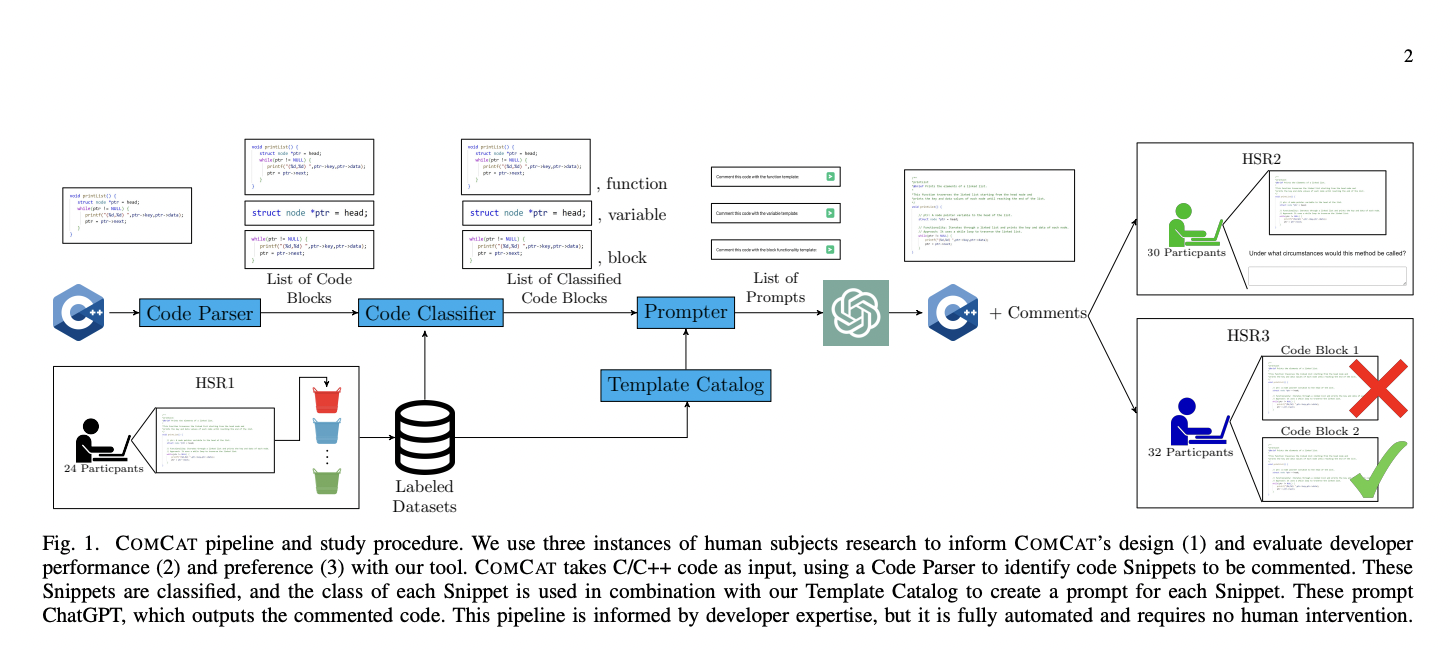COMCAT: Enhancing Software Maintenance through Automated Code Documentation and Improved Developer Comprehension Using Advanced Language Models

The field of software engineering continually evolves, with a significant focus on improving software maintenance and code comprehension. Automated code documentation is a critical area within this domain, aiming to enhance software readability and maintainability through advanced tools and techniques.
A major challenge in software maintenance is the high cost and effort associated with code comprehension. Developers spend considerable time understanding existing code, which can be inefficient and error-prone. This issue is particularly pronounced in large codebases where documentation may be sparse or outdated, leading to increased maintenance costs and reduced productivity. Estimates indicate that software maintenance accounts for 66% to 90% of total software lifetime costs, with approximately half attributed to code comprehension. Given these statistics, enhancing software readability and understanding is essential for cost-effectiveness and efficiency in software development and maintenance.
Existing methods for automated code documentation include template-based, information retrieval, and learning-based approaches. Template-based tools use predefined structures to generate comments, providing a consistent format. Information retrieval techniques extract and reuse existing documentation, leveraging databases or online sources to fill documentation gaps. Learning-based methods, particularly deep learning models, have shown promise in generating accurate and context-aware comments. These models train on large code and corresponding documentation datasets, improving their ability to produce relevant comments that enhance comprehension.
Researchers from Vanderbilt University and Universidad Nacional Autónoma de México introduced a novel tool called COMCAT. This tool leverages Large Language Models (LLMs) to generate comments that improve code comprehension. COMCAT uses a three-step pipeline: identifying suitable locations for comments, predicting the most helpful type of comment, and generating comments based on context and developer expertise. The tool’s design integrates human judgment to guide LLMs, enhancing their ability to produce comments that align with developers’ needs.
The COMCAT pipeline automates the documentation process by splitting source code into snippets, classifying these snippets, and using an LLM to generate relevant comments. The Code Parser component splits the code into segments that capture commonly used structures, such as loops and variable declarations. The Code Classifier then predicts the most helpful type of comment for each snippet, and the Prompter uses an LLM to generate a comment based on the selected location and comment type. This approach aims to provide comprehensive and accurate documentation that aligns with human developers’ needs, improving code’s overall readability and maintainability.
In a human subject evaluation involving 24 developers, the tool’s comments were at least as accurate and readable as human-generated ones. Developers preferred COMCAT-generated comments over standard ChatGPT-generated comments for up to 92% of code snippets. In a subsequent evaluation with 30 developers, COMCAT improved comprehension by an average of 12% for 87% of participants. This indicates that the tool significantly enhances developers’ ability to understand and work with code.
COMCAT’s ability to improve code comprehension is further supported by its extensive dataset of source code snippets, human-written comments, and human-annotated comment categories. This dataset, released for future research, provides a valuable resource for developing and refining automated code documentation tools. The tool’s effectiveness is attributed to its expertise-guided context generation, which tailors comments to developers’ needs, enhancing their comprehension and productivity.
In conclusion, COMCAT addresses the critical problem of code comprehension by leveraging LLMs and developer expertise, offering a method that enhances readability and maintainability. This innovation has the potential to substantially reduce the time and costs associated with software maintenance, making it a valuable asset for the software engineering community. The tool’s ability to provide accurate, readable, and preferred comments demonstrates its potential to supplant or supplement manual documentation efforts, contributing to more efficient and effective software development practices.
Check out the Paper. All credit for this research goes to the researchers of this project. Also, don’t forget to follow us on Twitter and join our Telegram Channel and LinkedIn Group. If you like our work, you will love our newsletter..
Don’t Forget to join our 46k+ ML SubReddit
Find Upcoming AI Webinars here
Sana Hassan, a consulting intern at Marktechpost and dual-degree student at IIT Madras, is passionate about applying technology and AI to address real-world challenges. With a keen interest in solving practical problems, he brings a fresh perspective to the intersection of AI and real-life solutions.


